James University Student Transport Research Report and Analysis
VerifiedAdded on 2023/06/09
|6
|1737
|448
Report
AI Summary
This report presents a research study conducted at James University to investigate the challenges faced by students regarding transportation to and from campus. The study aimed to determine the average distance and time students spend commuting, assess student satisfaction with current transport options, and identify preferred modes of transport. The research employed a mixed-methods approach, combining qualitative and quantitative data collection through questionnaires and interviews with students and staff. The report details the research design, sampling plan, data collection methods, and data analysis techniques used. Findings address the costs of transport, challenges associated with different modes of transport, and the impact of these challenges on student performance and class attendance. The report concludes with recommendations for improving student transport experiences and offers potential solutions to address the identified problems.

Running head: RESEARCH ON TRANSPORT 1
Name
Course
Lecturer
Date
Name
Course
Lecturer
Date
Paraphrase This Document
Need a fresh take? Get an instant paraphrase of this document with our AI Paraphraser
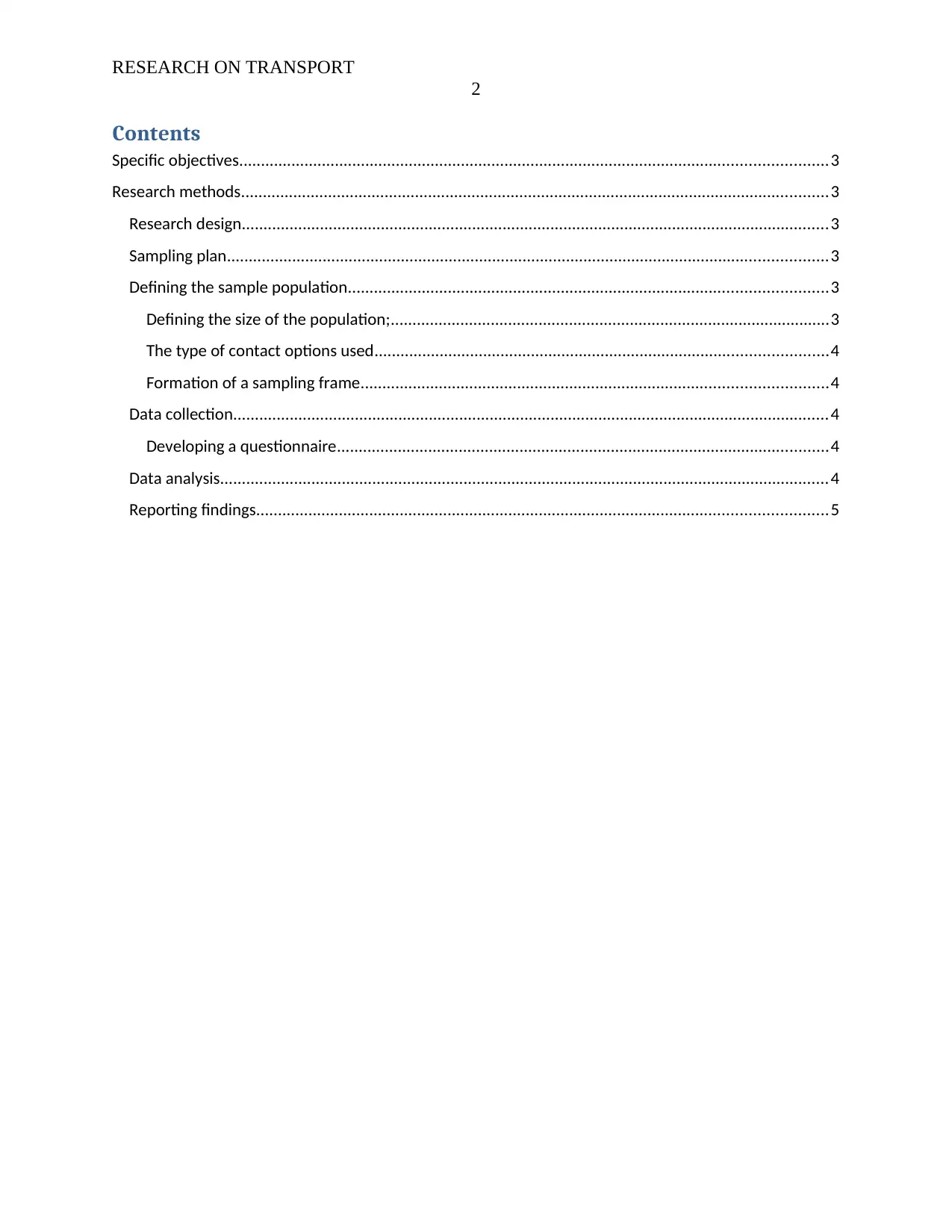
RESEARCH ON TRANSPORT
2
Contents
Specific objectives.......................................................................................................................................3
Research methods.......................................................................................................................................3
Research design.......................................................................................................................................3
Sampling plan..........................................................................................................................................3
Defining the sample population..............................................................................................................3
Defining the size of the population;.....................................................................................................3
The type of contact options used........................................................................................................4
Formation of a sampling frame...........................................................................................................4
Data collection.........................................................................................................................................4
Developing a questionnaire.................................................................................................................4
Data analysis............................................................................................................................................4
Reporting findings...................................................................................................................................5
2
Contents
Specific objectives.......................................................................................................................................3
Research methods.......................................................................................................................................3
Research design.......................................................................................................................................3
Sampling plan..........................................................................................................................................3
Defining the sample population..............................................................................................................3
Defining the size of the population;.....................................................................................................3
The type of contact options used........................................................................................................4
Formation of a sampling frame...........................................................................................................4
Data collection.........................................................................................................................................4
Developing a questionnaire.................................................................................................................4
Data analysis............................................................................................................................................4
Reporting findings...................................................................................................................................5
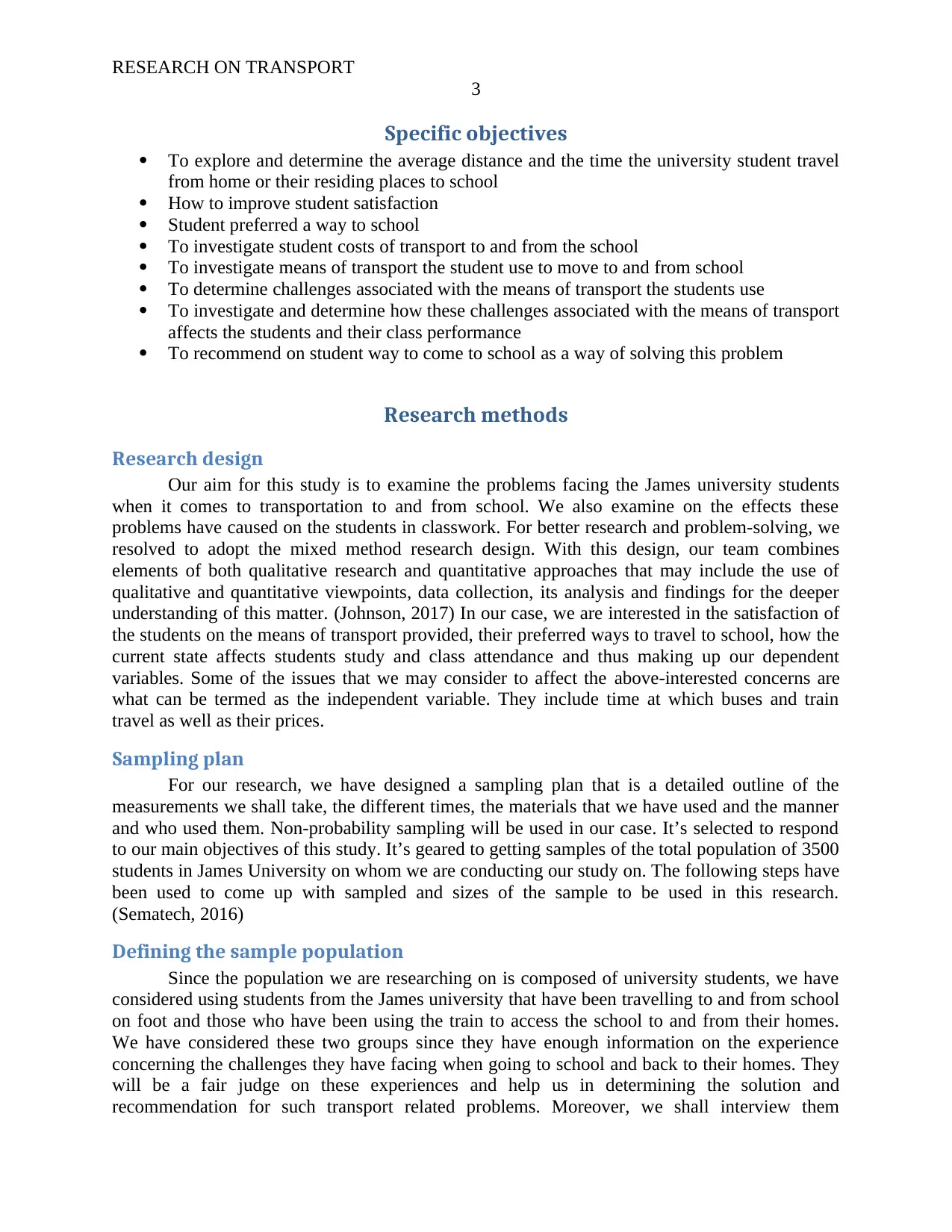
RESEARCH ON TRANSPORT
3
Specific objectives
To explore and determine the average distance and the time the university student travel
from home or their residing places to school
How to improve student satisfaction
Student preferred a way to school
To investigate student costs of transport to and from the school
To investigate means of transport the student use to move to and from school
To determine challenges associated with the means of transport the students use
To investigate and determine how these challenges associated with the means of transport
affects the students and their class performance
To recommend on student way to come to school as a way of solving this problem
Research methods
Research design
Our aim for this study is to examine the problems facing the James university students
when it comes to transportation to and from school. We also examine on the effects these
problems have caused on the students in classwork. For better research and problem-solving, we
resolved to adopt the mixed method research design. With this design, our team combines
elements of both qualitative research and quantitative approaches that may include the use of
qualitative and quantitative viewpoints, data collection, its analysis and findings for the deeper
understanding of this matter. (Johnson, 2017) In our case, we are interested in the satisfaction of
the students on the means of transport provided, their preferred ways to travel to school, how the
current state affects students study and class attendance and thus making up our dependent
variables. Some of the issues that we may consider to affect the above-interested concerns are
what can be termed as the independent variable. They include time at which buses and train
travel as well as their prices.
Sampling plan
For our research, we have designed a sampling plan that is a detailed outline of the
measurements we shall take, the different times, the materials that we have used and the manner
and who used them. Non-probability sampling will be used in our case. It’s selected to respond
to our main objectives of this study. It’s geared to getting samples of the total population of 3500
students in James University on whom we are conducting our study on. The following steps have
been used to come up with sampled and sizes of the sample to be used in this research.
(Sematech, 2016)
Defining the sample population
Since the population we are researching on is composed of university students, we have
considered using students from the James university that have been travelling to and from school
on foot and those who have been using the train to access the school to and from their homes.
We have considered these two groups since they have enough information on the experience
concerning the challenges they have facing when going to school and back to their homes. They
will be a fair judge on these experiences and help us in determining the solution and
recommendation for such transport related problems. Moreover, we shall interview them
3
Specific objectives
To explore and determine the average distance and the time the university student travel
from home or their residing places to school
How to improve student satisfaction
Student preferred a way to school
To investigate student costs of transport to and from the school
To investigate means of transport the student use to move to and from school
To determine challenges associated with the means of transport the students use
To investigate and determine how these challenges associated with the means of transport
affects the students and their class performance
To recommend on student way to come to school as a way of solving this problem
Research methods
Research design
Our aim for this study is to examine the problems facing the James university students
when it comes to transportation to and from school. We also examine on the effects these
problems have caused on the students in classwork. For better research and problem-solving, we
resolved to adopt the mixed method research design. With this design, our team combines
elements of both qualitative research and quantitative approaches that may include the use of
qualitative and quantitative viewpoints, data collection, its analysis and findings for the deeper
understanding of this matter. (Johnson, 2017) In our case, we are interested in the satisfaction of
the students on the means of transport provided, their preferred ways to travel to school, how the
current state affects students study and class attendance and thus making up our dependent
variables. Some of the issues that we may consider to affect the above-interested concerns are
what can be termed as the independent variable. They include time at which buses and train
travel as well as their prices.
Sampling plan
For our research, we have designed a sampling plan that is a detailed outline of the
measurements we shall take, the different times, the materials that we have used and the manner
and who used them. Non-probability sampling will be used in our case. It’s selected to respond
to our main objectives of this study. It’s geared to getting samples of the total population of 3500
students in James University on whom we are conducting our study on. The following steps have
been used to come up with sampled and sizes of the sample to be used in this research.
(Sematech, 2016)
Defining the sample population
Since the population we are researching on is composed of university students, we have
considered using students from the James university that have been travelling to and from school
on foot and those who have been using the train to access the school to and from their homes.
We have considered these two groups since they have enough information on the experience
concerning the challenges they have facing when going to school and back to their homes. They
will be a fair judge on these experiences and help us in determining the solution and
recommendation for such transport related problems. Moreover, we shall interview them
⊘ This is a preview!⊘
Do you want full access?
Subscribe today to unlock all pages.

Trusted by 1+ million students worldwide
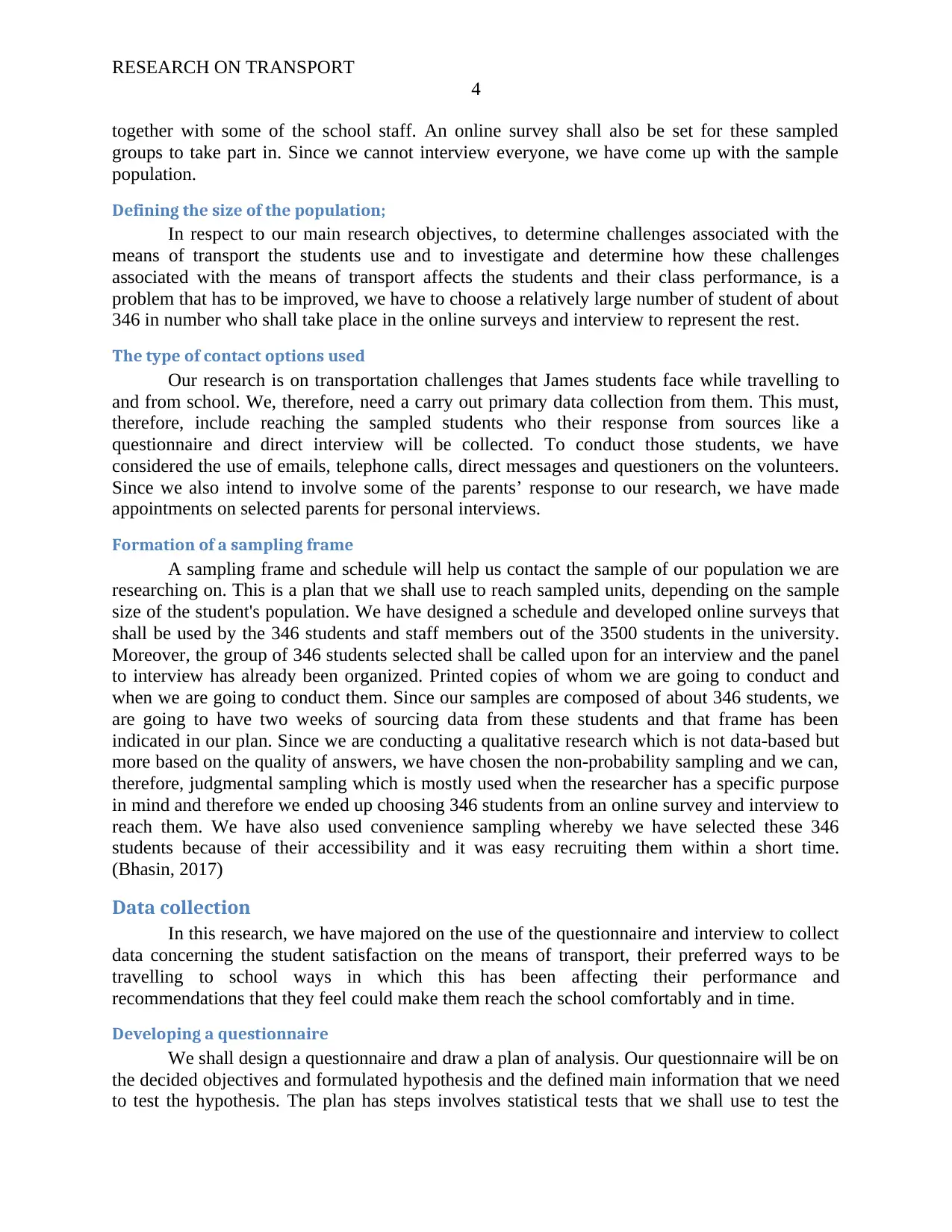
RESEARCH ON TRANSPORT
4
together with some of the school staff. An online survey shall also be set for these sampled
groups to take part in. Since we cannot interview everyone, we have come up with the sample
population.
Defining the size of the population;
In respect to our main research objectives, to determine challenges associated with the
means of transport the students use and to investigate and determine how these challenges
associated with the means of transport affects the students and their class performance, is a
problem that has to be improved, we have to choose a relatively large number of student of about
346 in number who shall take place in the online surveys and interview to represent the rest.
The type of contact options used
Our research is on transportation challenges that James students face while travelling to
and from school. We, therefore, need a carry out primary data collection from them. This must,
therefore, include reaching the sampled students who their response from sources like a
questionnaire and direct interview will be collected. To conduct those students, we have
considered the use of emails, telephone calls, direct messages and questioners on the volunteers.
Since we also intend to involve some of the parents’ response to our research, we have made
appointments on selected parents for personal interviews.
Formation of a sampling frame
A sampling frame and schedule will help us contact the sample of our population we are
researching on. This is a plan that we shall use to reach sampled units, depending on the sample
size of the student's population. We have designed a schedule and developed online surveys that
shall be used by the 346 students and staff members out of the 3500 students in the university.
Moreover, the group of 346 students selected shall be called upon for an interview and the panel
to interview has already been organized. Printed copies of whom we are going to conduct and
when we are going to conduct them. Since our samples are composed of about 346 students, we
are going to have two weeks of sourcing data from these students and that frame has been
indicated in our plan. Since we are conducting a qualitative research which is not data-based but
more based on the quality of answers, we have chosen the non-probability sampling and we can,
therefore, judgmental sampling which is mostly used when the researcher has a specific purpose
in mind and therefore we ended up choosing 346 students from an online survey and interview to
reach them. We have also used convenience sampling whereby we have selected these 346
students because of their accessibility and it was easy recruiting them within a short time.
(Bhasin, 2017)
Data collection
In this research, we have majored on the use of the questionnaire and interview to collect
data concerning the student satisfaction on the means of transport, their preferred ways to be
travelling to school ways in which this has been affecting their performance and
recommendations that they feel could make them reach the school comfortably and in time.
Developing a questionnaire
We shall design a questionnaire and draw a plan of analysis. Our questionnaire will be on
the decided objectives and formulated hypothesis and the defined main information that we need
to test the hypothesis. The plan has steps involves statistical tests that we shall use to test the
4
together with some of the school staff. An online survey shall also be set for these sampled
groups to take part in. Since we cannot interview everyone, we have come up with the sample
population.
Defining the size of the population;
In respect to our main research objectives, to determine challenges associated with the
means of transport the students use and to investigate and determine how these challenges
associated with the means of transport affects the students and their class performance, is a
problem that has to be improved, we have to choose a relatively large number of student of about
346 in number who shall take place in the online surveys and interview to represent the rest.
The type of contact options used
Our research is on transportation challenges that James students face while travelling to
and from school. We, therefore, need a carry out primary data collection from them. This must,
therefore, include reaching the sampled students who their response from sources like a
questionnaire and direct interview will be collected. To conduct those students, we have
considered the use of emails, telephone calls, direct messages and questioners on the volunteers.
Since we also intend to involve some of the parents’ response to our research, we have made
appointments on selected parents for personal interviews.
Formation of a sampling frame
A sampling frame and schedule will help us contact the sample of our population we are
researching on. This is a plan that we shall use to reach sampled units, depending on the sample
size of the student's population. We have designed a schedule and developed online surveys that
shall be used by the 346 students and staff members out of the 3500 students in the university.
Moreover, the group of 346 students selected shall be called upon for an interview and the panel
to interview has already been organized. Printed copies of whom we are going to conduct and
when we are going to conduct them. Since our samples are composed of about 346 students, we
are going to have two weeks of sourcing data from these students and that frame has been
indicated in our plan. Since we are conducting a qualitative research which is not data-based but
more based on the quality of answers, we have chosen the non-probability sampling and we can,
therefore, judgmental sampling which is mostly used when the researcher has a specific purpose
in mind and therefore we ended up choosing 346 students from an online survey and interview to
reach them. We have also used convenience sampling whereby we have selected these 346
students because of their accessibility and it was easy recruiting them within a short time.
(Bhasin, 2017)
Data collection
In this research, we have majored on the use of the questionnaire and interview to collect
data concerning the student satisfaction on the means of transport, their preferred ways to be
travelling to school ways in which this has been affecting their performance and
recommendations that they feel could make them reach the school comfortably and in time.
Developing a questionnaire
We shall design a questionnaire and draw a plan of analysis. Our questionnaire will be on
the decided objectives and formulated hypothesis and the defined main information that we need
to test the hypothesis. The plan has steps involves statistical tests that we shall use to test the
Paraphrase This Document
Need a fresh take? Get an instant paraphrase of this document with our AI Paraphraser
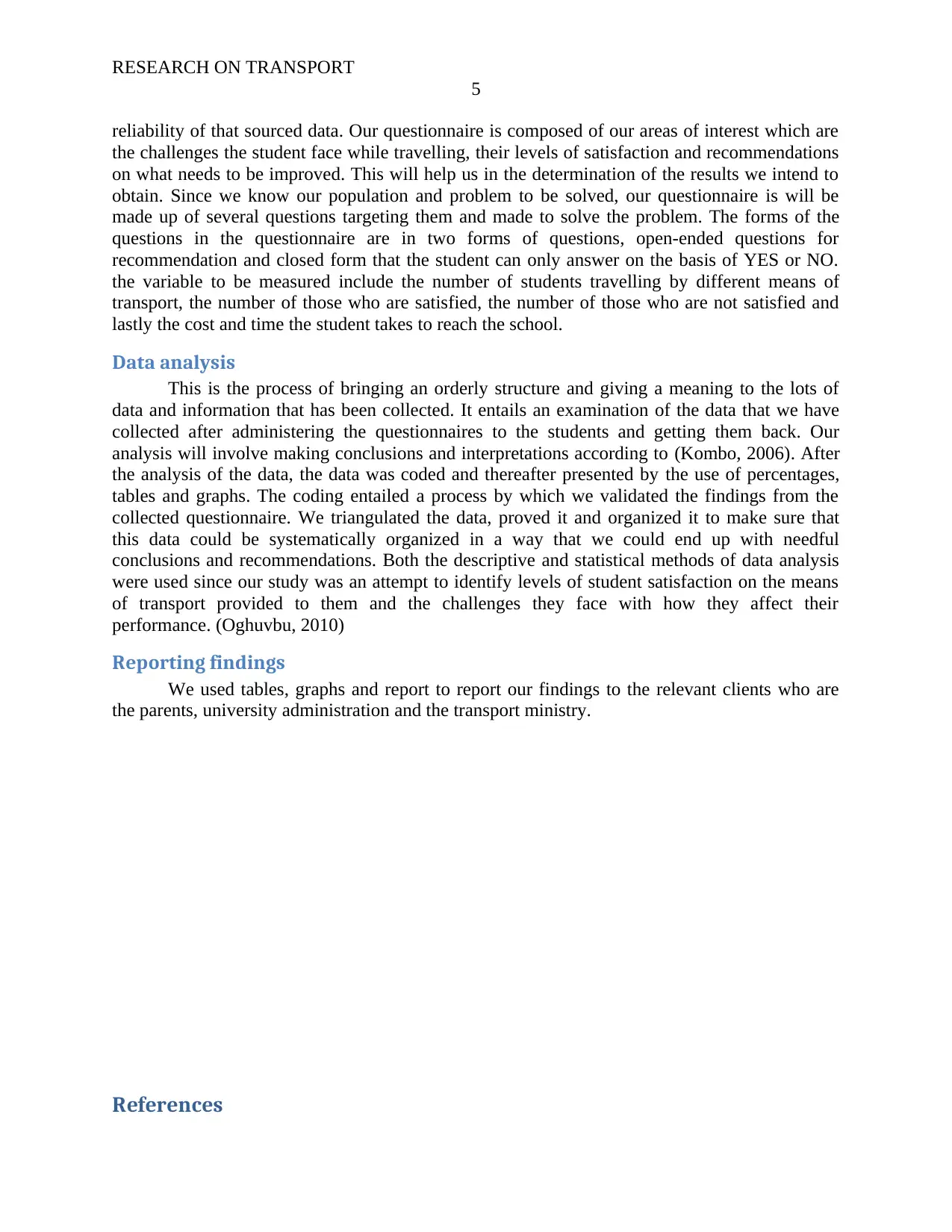
RESEARCH ON TRANSPORT
5
reliability of that sourced data. Our questionnaire is composed of our areas of interest which are
the challenges the student face while travelling, their levels of satisfaction and recommendations
on what needs to be improved. This will help us in the determination of the results we intend to
obtain. Since we know our population and problem to be solved, our questionnaire is will be
made up of several questions targeting them and made to solve the problem. The forms of the
questions in the questionnaire are in two forms of questions, open-ended questions for
recommendation and closed form that the student can only answer on the basis of YES or NO.
the variable to be measured include the number of students travelling by different means of
transport, the number of those who are satisfied, the number of those who are not satisfied and
lastly the cost and time the student takes to reach the school.
Data analysis
This is the process of bringing an orderly structure and giving a meaning to the lots of
data and information that has been collected. It entails an examination of the data that we have
collected after administering the questionnaires to the students and getting them back. Our
analysis will involve making conclusions and interpretations according to (Kombo, 2006). After
the analysis of the data, the data was coded and thereafter presented by the use of percentages,
tables and graphs. The coding entailed a process by which we validated the findings from the
collected questionnaire. We triangulated the data, proved it and organized it to make sure that
this data could be systematically organized in a way that we could end up with needful
conclusions and recommendations. Both the descriptive and statistical methods of data analysis
were used since our study was an attempt to identify levels of student satisfaction on the means
of transport provided to them and the challenges they face with how they affect their
performance. (Oghuvbu, 2010)
Reporting findings
We used tables, graphs and report to report our findings to the relevant clients who are
the parents, university administration and the transport ministry.
References
5
reliability of that sourced data. Our questionnaire is composed of our areas of interest which are
the challenges the student face while travelling, their levels of satisfaction and recommendations
on what needs to be improved. This will help us in the determination of the results we intend to
obtain. Since we know our population and problem to be solved, our questionnaire is will be
made up of several questions targeting them and made to solve the problem. The forms of the
questions in the questionnaire are in two forms of questions, open-ended questions for
recommendation and closed form that the student can only answer on the basis of YES or NO.
the variable to be measured include the number of students travelling by different means of
transport, the number of those who are satisfied, the number of those who are not satisfied and
lastly the cost and time the student takes to reach the school.
Data analysis
This is the process of bringing an orderly structure and giving a meaning to the lots of
data and information that has been collected. It entails an examination of the data that we have
collected after administering the questionnaires to the students and getting them back. Our
analysis will involve making conclusions and interpretations according to (Kombo, 2006). After
the analysis of the data, the data was coded and thereafter presented by the use of percentages,
tables and graphs. The coding entailed a process by which we validated the findings from the
collected questionnaire. We triangulated the data, proved it and organized it to make sure that
this data could be systematically organized in a way that we could end up with needful
conclusions and recommendations. Both the descriptive and statistical methods of data analysis
were used since our study was an attempt to identify levels of student satisfaction on the means
of transport provided to them and the challenges they face with how they affect their
performance. (Oghuvbu, 2010)
Reporting findings
We used tables, graphs and report to report our findings to the relevant clients who are
the parents, university administration and the transport ministry.
References
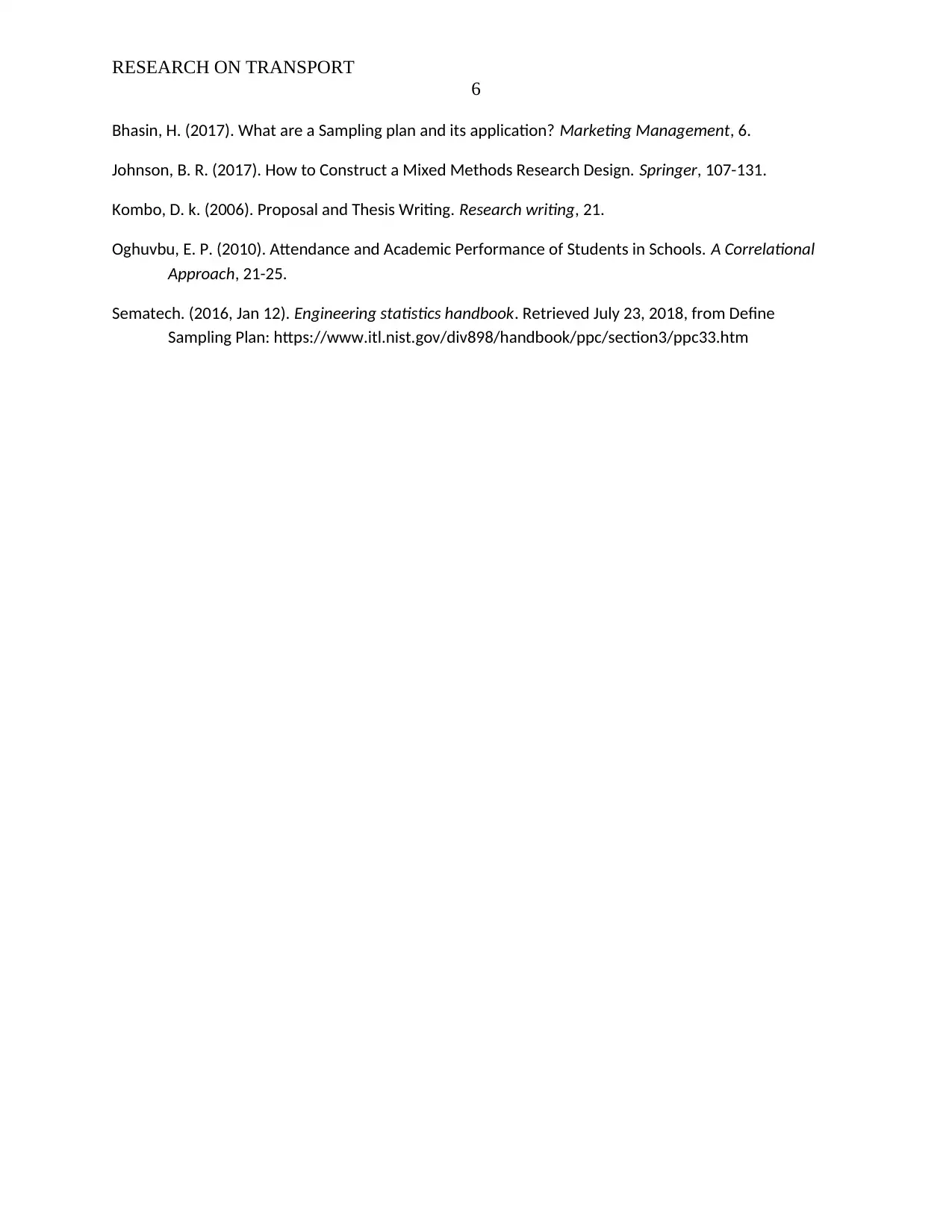
RESEARCH ON TRANSPORT
6
Bhasin, H. (2017). What are a Sampling plan and its application? Marketing Management, 6.
Johnson, B. R. (2017). How to Construct a Mixed Methods Research Design. Springer, 107-131.
Kombo, D. k. (2006). Proposal and Thesis Writing. Research writing, 21.
Oghuvbu, E. P. (2010). Attendance and Academic Performance of Students in Schools. A Correlational
Approach, 21-25.
Sematech. (2016, Jan 12). Engineering statistics handbook. Retrieved July 23, 2018, from Define
Sampling Plan: https://www.itl.nist.gov/div898/handbook/ppc/section3/ppc33.htm
6
Bhasin, H. (2017). What are a Sampling plan and its application? Marketing Management, 6.
Johnson, B. R. (2017). How to Construct a Mixed Methods Research Design. Springer, 107-131.
Kombo, D. k. (2006). Proposal and Thesis Writing. Research writing, 21.
Oghuvbu, E. P. (2010). Attendance and Academic Performance of Students in Schools. A Correlational
Approach, 21-25.
Sematech. (2016, Jan 12). Engineering statistics handbook. Retrieved July 23, 2018, from Define
Sampling Plan: https://www.itl.nist.gov/div898/handbook/ppc/section3/ppc33.htm
⊘ This is a preview!⊘
Do you want full access?
Subscribe today to unlock all pages.

Trusted by 1+ million students worldwide
1 out of 6
Related Documents
Your All-in-One AI-Powered Toolkit for Academic Success.
+13062052269
info@desklib.com
Available 24*7 on WhatsApp / Email
![[object Object]](/_next/static/media/star-bottom.7253800d.svg)
Unlock your academic potential
Copyright © 2020–2025 A2Z Services. All Rights Reserved. Developed and managed by ZUCOL.





